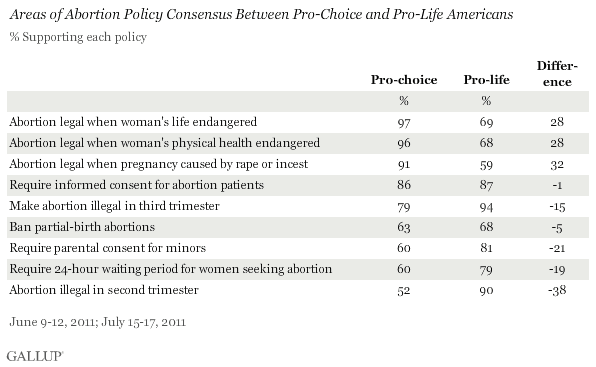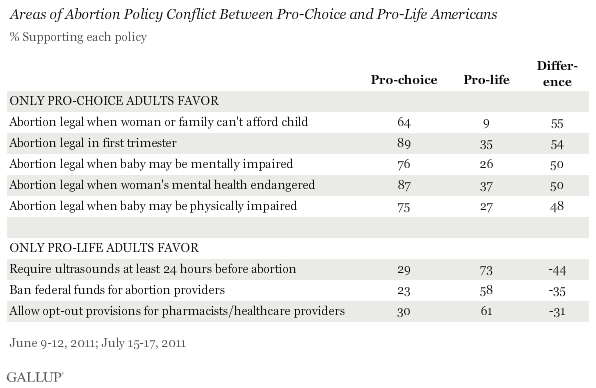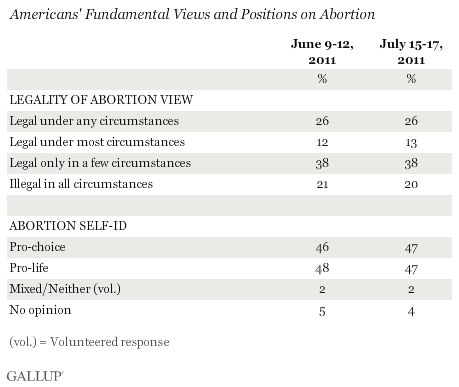PRINCETON, NJ -- Self-described "pro-choice" and "pro-life" Americans agree about nine major areas of abortion policy, while disagreeing on eight others. Among the areas of consensus, in which a majority of both groups hold the same opinion, especially large percentages are in favor of requiring informed consent for women (86% of pro-choice adults and 87% who are pro-life) and making abortion illegal in the third trimester (79% and 94%).

Pro-life and pro-choice Americans also broadly agree that abortion should be legal when a woman's life or physical health is endangered by pregnancy and when pregnancy is caused by rape or incest. Both groups favor banning "partial-birth abortions," and requiring parental consent for minors. Additionally, a slim majority of pro-choice Americans (52%) agree with 90% of pro-life Americans that abortion should be illegal in the second trimester.
Pro-Life Adults Reject Financial Burden as Abortion Rationale
The most contentious area of abortion policy has to do with abortions conducted for financial reasons. Nearly two-thirds of pro-choice adults, 64%, compared with only 9% of pro-life Americans, say abortion should be legal when the woman or family cannot afford to raise the child.
This 55-percentage-point gap in views is nearly matched by the divergence in support for first-trimester abortions, and for abortions done when the baby may be mentally or physically impaired, or when the mother's mental health is at stake. All of these positions are favored by most pro-choice Americans, compared with fewer than 40% of pro-life adults.
Additionally, most pro-life adults support three abortion-related regulations that are backed by no more than 30% of pro-choice adults. These are requiring women to be shown an ultrasound of her fetus before having an abortion, banning federal funds for clinics that provide abortions, and allowing pharmacists and healthcare providers to opt out of dispensing medicine or participating in procedures that result in abortion.

Gallup measured U.S. public support for the legality of abortion in each of seven specific circumstances, as well as in each trimester, in a June 9-12 national survey. A follow-up survey conducted July 15-17 measured Americans' support for several different abortion regulations that have become common across the states, as well as for abortion funding policies. Both surveys probed Americans' fundamental views on the legality of abortion as well as their abortion position using the pro-choice and pro-life labels, with similar results.

It should be noted that support for abortion by trimester is also complex and can depend on the rationale -- as past Gallup research has found. However, broadly speaking, Americans are more supportive of legalizing abortion in the earliest stages of pregnancy than in the later stages, when the fetus is more fully developed or could survive outside the womb.
Implications
Abortion politics have been quite contentious in the United States; however, self-described "pro-life" and "pro-choice" Americans broadly agree on more than half of 16 major abortion policy matters Gallup tested in June and July. These policies generally have to do with protections for women's vital health, preventing late-term abortions, and ensuring that abortion patients and parents are fully informed before an abortion.
While such positions may not square with those taken by the leading pro-choice and pro-life lobbying groups in Washington, enacting them would greatly narrow the scope of the debate among Americans as a whole. That would leave first-trimester abortions, abortions performed when physical or mental impairments of the fetus are indicated, when the mother's mental health is endangered, and abortions performed for financial reasons as the main areas of contention over abortion. In addition, laws that require pregnant women to be shown ultrasounds, policies that allow healthcare professionals to opt out of participating in abortions, and banning federal funds to abortion providers would continue to generate controversy.
Survey Methods
Results are based on two Gallup polls, one conducted June 9-12, 2011, with a random sample of 1,020 adults, and the other conducted July 15-17, 2011, with a random sample of 1,016 adults. Both surveys are based on adults aged 18 and older, living in all 50 U.S. states and the District of Columbia.
For results based on the total sample of national adults in each survey, one can say with 95% confidence that the maximum margin of sampling error is ±4 percentage points.
For results based on pro-choice and pro-life Americans from each survey, one can say with 95% confidence that the maximum margin of sampling error is ±5 percentage points.
Interviews are conducted with respondents on landline telephones and cellular phones, with interviews conducted in Spanish for respondents who are primarily Spanish-speaking. Each sample includes a minimum quota of 400 cell phone respondents and 600 landline respondents per 1,000 national adults, with additional minimum quotas among landline respondents by region. Landline telephone numbers are chosen at random among listed telephone numbers. Cell phone numbers are selected using random-digit-dial methods. Landline respondents are chosen at random within each household on the basis of which member had the most recent birthday.
Samples are weighted by gender, age, race, Hispanic ethnicity, education, region, adults in the household, and phone status (cell phone only/landline only/both, cell phone mostly, and having an unlisted landline number). Demographic weighting targets are based on the March 2010 Current Population Survey figures for the aged 18 and older non-institutionalized population living in U.S. telephone households. All reported margins of sampling error include the computed design effects for weighting and sample design.
In addition to sampling error, question wording and practical difficulties in conducting surveys can introduce error or bias into the findings of public opinion polls.
View methodology, full question results, and trend data.
For more details on Gallup's polling methodology, visit www.gallup.com.
